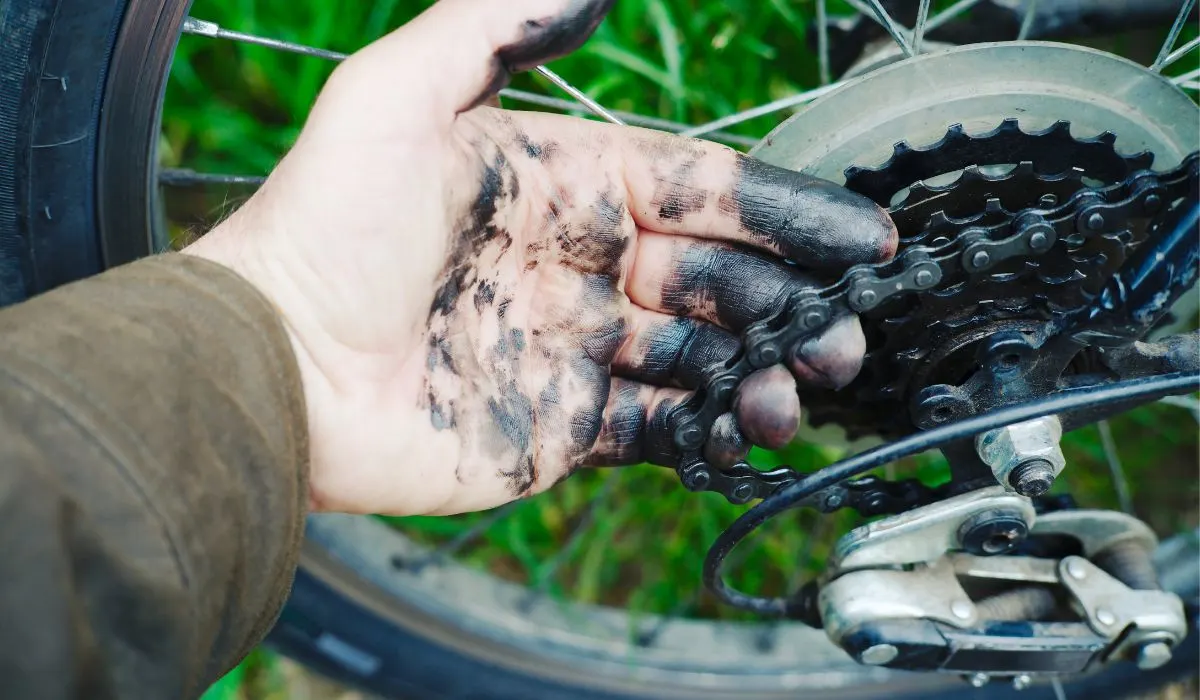
Bicycles have different components, requiring grease or a lubricant to prevent damage to the bike’s metal components. Many cyclists look for alternatives for bike-specific grease and lubricants. This is because these products can be expensive, or the cyclist doesn’t have any on hand and needs to lubricate their bike chain.
Good alternative bike grease or lubricant options include:
- clipper oil
- silicone spray
- 3-in-1 oil
- homemade wax
- chainsaw oil
Bike grease no-go’s that might damage your chain and components include:
- petroleum jelly
- vegetable oils
- motor oils
- gear oils
- machine oils
- WD40
Lubricants are made from 80 to 98% base oils and have additives to prevent corrosion, and rust and to repel water. Using the wrong type of lubricant on your bike may cost you a lot more money or effort to get your bike into optimal riding condition again.
5 Alternatives To Bike Grease
Bike-specific lubricants have been designed for bikes, and it is often recommended that you use them to help your bike’s components work optimally. However, they can be expensive unless you buy them in bulk.
Whether you are looking to save money or need a quick alternative to bike chain grease, here are some alternatives all easily available that you can use on your bike’s chain: (I’ve linked to the product on Amazon where applicable):
1. Clipper Oil
3. 3-In-1 Oil
4. Liquid Wax
5. Chainsaw Oil

#1: Clipper Oil
Clipper oil is used in electric hair clippers to aid the blades in moving smoothly. Since the blades slide so closely together, a finer oil is better to get into the gap.
Using clipper oil on your bike chain may require frequent re-application, which could be troublesome. However, clipper oils have anti-rust additives and are odorless.
You can find it on Amazon here.
#2: Silicone Spray
Silicone spray has similar longevity to clipper oil when used on bike chains, meaning you need to reapply it after each ride. However, the benefit of silicone spray is that it is non-toxic and dries fast.
Because of its consistency, silicone spray will also penetrate the spring pivots and derailleur easily. It’s available from Amazon here.
#3: 3-In-1-Oil
3-in-1 oils are multi-purpose oils that can be used for lubricating bike chains. These oils are naphthenic, meaning they have a lower viscosity. Compared to other lubricants, 3-in-1 oil is better at preventing speed and power loss when cycling.
Another benefit of 3-in-1 oil is that it protects bike chains against wear and tear and does not attract dirt. It also does not degrade quickly, making it one of the best grease alternatives for bike chains.
You can find on here at Amazon.
#4: Liquid Wax
Liquid wax has been used on bike chains for decades because it protects them by not attracting dirt and water. You can find it on Amazon here.
Unfortunately, bike chain wax can be expensive, but it is cost-effective to make your own. The following video shows how you can make your own liquid bike chain wax with three simple ingredients:
#5: Chainsaw (Bar) Oil

Chainsaw oil is designed to stick to a chain that spins at high RPMs, so chainsaw oil is stickier than bike chain lubricant.
Unfortunately, it will make dirt stick to your chain, so it is best to use chainsaw oil only if you often ride in wet weather where dirt will wash off.
6 Bike Grease No-Go’s
Using the wrong type of grease or lubricant on your bike chain may seem like a quick fix or a cheap alternative at the time, but the opposite is often the case. So, what should you avoid using on your bike chain?
1. Petroleum Jelly
2. Vegetable Oils
3. Motor Oils
4. Gear Oils
5. Machine Oils
6. WD-40
#1: Petroleum Jelly
Petroleum jelly is not designed to work on high-heat components like bike chains. The other disadvantages of petroleum jelly are:
- It does not last long.
- It is more expensive than regular bike lubricants.
- It is sticky and attracts dirt, and is not easy to clean.
#2: Vegetable Oils
Vegetable oils reduce friction on bike chains similarly to bike-specific lubricants. However, vegetable oils pick up a lot of dirt, which will clog up your chain and other bike components.
In addition, vegetable oils do not protect against corrosion and will degrade quickly due to oxidization. Finally, castor oil is too thick to penetrate the rollers on a bicycle chain, making it a poor lubricant for bikes.
NOTE: Vegetable oils should only be used in an emergency and cleaned off as soon as possible.
#3: Motor Oils
Motor oils are designed for a closed system on an engine, so exposure to the elements will cause them to oxidize. Therefore, the additives to motor oil will not improve the performance of your bike, nor will it reduce wear.
Also, motor oil is too thick for a bicycle chain and will not penetrate the inner components properly. If you must use motor oil on your bike’s chain, it is best to thin it out beforehand.
#4: Gear Oil
Gear oil is designed to lubricate the inner workings of:
- transfer cases
- transmissions
- automobile differentials
Unfortunately, the additives in gear oils will not improve the performance of your bike. Gear oil is too thick to penetrate the rollers and finer components of your bike’s chain, and its high viscosity attracts debris and dirt.
#5: Machine Oil
Sewing machines and other light machines use white mineral oil or almost-pure base oils. Unfortunately, these oils lack performance-enhancing and anti-wear additives for your bike chain.
NOTE: Machine oil can be used on your bike chain, but is not recommended.

#6: WD40
WD40 is not a lubricant suitable for bicycle chains. It is a solvent, meaning you would use it to clean your chain before lubricating it.
It has rust-prevention and degreasing properties and can be a light lubricant on small items, including locks or hinges. However, bicycle chains are too fast-moving and heavy to benefit from the lubricating effects of WD40.
The following video talks about the origins of WD40 and why it should not be used on a bike chain:
Conclusion
When using an alternative grease for your bike, knowing which alternatives are okay and what to avoid is good knowledge to have.
Options you can use to lubricate your bike chain include:
- clipper oil
- silicone spray
- 3-in-1 oil
- liquid wax
- chainsaw oil (for wet riding)
On your bike chain, it is best to avoid:
- petroleum jelly
- vegetable oils
- motor oils
- gear oils
- machine oils
- WD40 on your bike chain
You might also be interested in:
